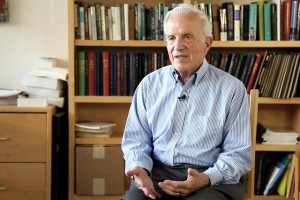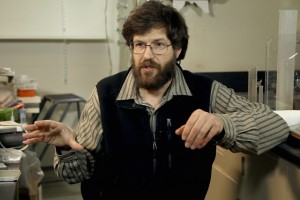Alcoholism
Neuroscientist John Krystal on alcohol's action on the brain, social and habitual drinking, and why some peopl...
How can a tunable laser be created? What possibilities does a tunable laser open? How can one diagnose cancer by analyzing breath? These and other questions are answered by Robert L. Wallace Professor of Applied Physics at Harvard University Federico Capasso.
The Quantum Cascade Laser is an electronic waterfall. Essentially we design and then build a semiconductor material such that when you apply a voltage to it, what happens is that the electrons go through the actual material, and because this design is an energy staircase at every step that the electrons jump down they emit a laser photon. So it’s a fundamentally new laser principle. And the key point is by engineering, by designing, by changing the size of the energy step we can actually change the wave length. So conceptually it’s very simple. In this way this is an artificial material which is man-made where we can design the emission wave length across a region of the spectrum called the mid-infrared to far-infrared which goes from a few microns to hundreds of microns. Until now, until the advent of the Quantum Cascade Laser just only a few laser could emit just a few wave lengths.
Right now with a QCL we can cover most of it. And most important once we even make a laser at a particular wave length, we can actually tune around it. Pretty largely show these are lasers tillable in a sense that you design a wave length. And tunable – the once you fixed the design by changing the current and the temperature (2.00) you can actually do a pretty large tuning of the wave length.
Quantum Cascade Lasers, in the words of my colleagues at Harvard Professor Jim Anderson and Professor Steve Wofsy, are revolutionizing atmospheric chemistry.
Because of their ability they flow these quantum cascade lasers in aircrafts that go start very low from the troposphere to the stratosphere – these are both manned aircrafts and robotic aircrafts. And they’ve been able to measure tinyclous entrition of the greenhouse gases with high precision at various heights from locals to the ground very high. And this is important for prediction of climate changes.
So applications are opening up in the medical field: breathe analysis is a very exciting one for diseases. You know, the idea is very simple: you breath into a chamber, okay, a laser bounces back and forth. You tune the laser, and if you see by tuning the laser that at some point light is absorbed, that tells you have certain stuff in your breath and you can go back. So this is starting to be used in research for diagnostics of ulcer, colon cancers and other applications. So this is future ones. And there are about twenty companies, and I have started my own company in Quantum Cascade Laser. And our goal there is (the company is called Eos Photonics) to make a kind of what I call a universal sensor. This is a chip that we can tune. It contains many of these lasers and we can fast tune the wave length over a huge range, and why this is important to detect simultaneously a large number of chemicals.
It’s interesting from a fundamental science because the principle under the Quantum Cascade Lasers are very different. Conventionally there you see QCL is made of a semiconductor. Semiconductors are material such as Gallium Arsenide, Indium Phosphide and so forth. And semiconductor lasers, you know, are widely spread in the world. In fact all communication, fiber communication are based on semiconductor lasers. The QCL is a semiconductor laser but very different from the one that I’ve just talked. And again the key point is you can design the emission wave length not by changing the material which makes it very difficult – if you want to change the wave length at each time you have to change the material, you have a problem every time you make a laser to make a new laser. Here we can cover the whole mid-infrared spectrum by changing the layers, thin layers of the active region. And in this way we can make it widely tillable and also tunable.
The challenge was to make a compact laser, in fact, a semiconductor laser, a tiny laser, that’ll work efficiently in a region of the spectrum where there was until then (mid 90s) no good semiconductor laser, in generally, no good laser. Except at very specific wave length. So we had this very interesting region of the spectrum where there were not many good lasers. So challenge and the key point was to realize that if we were able to engineer particular semiconductors using nanotechnology made of nanometer thin layers, we could invent, if you like, a new laser scheme, a new laser principle. We could design a laser that we could tell it at what wave length to emit (over a wide region this was a huge step forward) and then make it widely tunable. Now this has been done. What is the challenge? The challenge now is to push this laser at even longer wave length. They work extremely well. They are powerful, they work at room temperature. But up to wave length, you know, about 10-15 microns. The challenge is how we can make a high performance QCL that works at room temperature with reasonably high power at hundred microns. This is far-infrared. This will open up new applications. And, yes, we have found an approach recently which has shown a path to higher power so this has been a breakthrough in the sphere by a laboratory that has been able to achieve milliwatts of power level at room temperature at very long wave length. So this is an exciting area of research. Another one that we have been working on and this actually opens for us the area of flat optics. It is the following . You see, one of my colleagues at Harvard asked me a key question once (maybe he doesn’t remember but I remember very well – that’s professor Jim Anderson). He says: Federico, I want to fly your laser in my robotic aircrafts. In a robotic aircraft there is very little space. This is a drone. So these lasers they emit a widely divergent light. This is typical of all semiconductor lasers. He says: Federico, I don’t want to put optics in this little space. I don’t have space. Can you somehow find a way to collimate the light so that instead of being divergent it comes out parallel?
So this made us think. With a student of mine we found a way where we could pattern the facet of these lasers with a nanostructure and metal nanostructure.
So without using any outside lens, any optics we get a highly collimated beam. This has been a breakthrough which has actually led us (this first tentative step) to flat optics and so forth.
So beam engineering, the ability to engineer not only the wave length, but the quality of the beam coming out, make it collimated.
Then I had another brilliant student from France from the Ecole Polytechnique, I asked him: can you design a laser that emits multiple beams in different directions – this sounds like Star Wars, right? And he did it. Okay? He designed the facet of the laser, he patterned it in the way that this laser emits light simultaneously in various direction of space which you can design. And so this opens up. And the next thing now: can we make a laser that emits simultaneously in many wave lengths. This sounds strange. It’s a laser? Yes. It’s called broadband or supercontinuum. And so we had been able to make QCL that emits simultaneously in many wave lengths which is important scientifically and for application. So it’s kind of coming all together.
So the significance of this is what I see that QC Laser is providing a solution for many important technology problems and the application area is dramatically expanding right now. You know from sensing to high power application, medicine, industrial application, combustion diagnostics and so forth. Scientifically there are still many open problems because the fundamentals of this laser are still not completely understood. It is still a young laser. So every year we are discovering new things. I don’t have the time to elaborate but we discovered two years ago together with a Russian scientist and others… we discovered a phenomenon in this laser predicted back in the 60s and never been observed before. So it’s really a treasure trove of new science and new technology. And we are just starting to see, I think, particularly applications to atmospheric science chemistry will be huge.

Neuroscientist John Krystal on alcohol's action on the brain, social and habitual drinking, and why some peopl...

Physicist Daniel Kleppner on precise time measurements, gravitational field, and the Global Positioning System

Associate Prof. Konstantin Khrapko of Harvard University on mutations in non-nuclear DNA, substantia nigra, an...